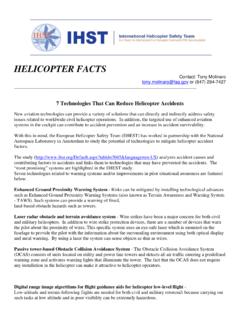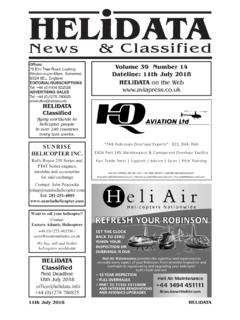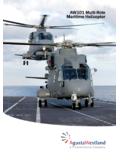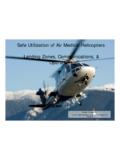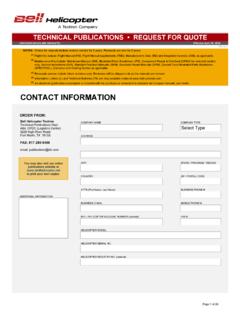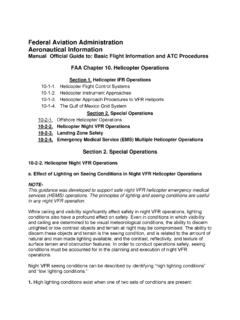Transcription of UK offshore public transport helicopter safety records ...
1 UK offshore public transport helicopter safety RECORD(1976 2002) Prepared byJohn Burt Associates Limited / BOMEL Limitedfor the Health and safety ExecutiveINTENTIONALLY BLANK iDISCLAIMERThis report and the work it describes were funded by the Health and safety Executive. Its contents,including any opinions and/or conclusions expressed, are those of the author(s) alone and do notnecessarily reflect HSE Crown copyright 2004 All rights reserved. No part of this publication may bereproduced, stored in a retrieval system, or transmitted inany form or by any means (electronic, mechanical,photocopying, recording or otherwise) without the priorwritten permission of the copyright for reproduction should be made in writing to:Licensing Division, Her Majesty's Stationery Office,St Clements House, 2-16 Colegate, Norwich NR3 1 BQor by e-mail to BLANK ivCONTENTSPage No.
2 EXECUTIVE SUMMARYVI1. INTRODUCTION AND INTRODUCTION BACKGROUND SOURCES AND DATA offshore public transport helicopter safety RECORD INTRODUCTION helicopter ACCIDENTS AND FLIGHT FATAL ACCIDENT RATE AND NON-FATAL REPORTABLE offshore helicopter safety OF UK offshore helicopter safety RECORD 1976 -2002 WITH OTHER INTRODUCTION UKCS WITH WORLD-WIDE offshore helicopter OTHER transport MODES225. CONCLUSIONS 246. ABBREVIATIONS AND DEFINITIONS26 APPENDIX 1 v UK offshore public transport helicopter safety RECORD(1976 2002)EXECUTIVE SUMMARYThis report was commissioned by the Health and safety Executive (HSE) with the support of the CivilAviation Authority (CAA), to produce a safety record of UKCS offshore helicopter operations and to makecomparisons with various other modes of offshore helicopter operations data covering 27 years (1976 to 2002) are available for analysis andcomparison, and have been grouped into three 9-year inclusive periods as follows: 1976 to 1984, 1985 to 1993, and 1994 to 2002.
3 It should be noted, however, that the data sets used to obtain accident rates for offshore helicopter operations are relatively small, hence caution is required when interpreting the 1976 up to year-end 2002, just over 48 million passengers were transported to and from offshoreinstallations on the UKCS. Over 6 million sectors were flown taking about million flying hours. During this time 7 fatal accidents claimed the lives of 88 offshore workers and flight crew. As a measure of currentUKCS activity, some 160,000 sectors were flown in 2002 transporting over million passengers offshoreand sector flight times averaged just over 30 the first 18 years (1976 to 1993) 6 fatal accidents were recorded (3 in each 9-year period of review).
4 During the last 9 years 1994 to 2002 there was one fatal accident and this occurred in July component failure was the primary cause of 4 accidents and the other 3 were attributed to human non-fatal reportable accidents were recorded during the first 18 years of UKCS offshore helicopteroperations, 20 in the period 1976 to 1984 and 22 in the period 1985 to 1993. Between 1994 and 2002 there were 8 non-fatal reportable accidents and, taking into account the corresponding rates for the three periods(see Table ), this represents a significant reduction on the previous two for World Wide and All North Sea offshore helicopter operations is available from the International Oil& Gas Producers Association (OGP), but is limited to the period 1995 - 2002.
5 Table 1 overleaf compares the global fatal and non-fatal accident rates with UKCS helicopter operations during this period with both fataland non-fatal accident rates based on 100,000 flying hours / sectors (flight stages) flown. For the period1995 to 2002, the UKCS recorded one fatal accident whereas 3 fatal accidents were recorded for All North Sea operations and 40 Worldwide. The UKCS fatal accident rate (flying hours) compares favourably withthe figure for Worldwide operations and is lower than the rate for All North Sea. For the same period, non-fatal reportable accident rates for flying hours for the UKCS are lower than, but similar to All North Sea and Worldwide operations. The non-fatal reportable accident rates for sectors show the UKCS to be better thanAll North Sea and virtually the same as Worldwide (Flying Hrs.)
6 NON-FATALACCIDENTRATES(Flying Hrs.)FATALACCIDENTRATES(Sectors)NON-FATA LACCIDENTRATES(Sectors)All North Sea1995 - 2002 - 2002 - 1 Comparison of UKCS Accident Rates with OGP Worldwide Average Fatal and Reportable Accident Rates 1995 to 2002 Comparing offshore helicopter operations with other forms of transport used in the UK ( car, train, pedalcycle) provides a useful comparison with everyday experience. The latest available data from the DETR(1992 to 2001) indicates that the safety record of offshore helicopter travel compares favourably with other forms of commonly used land-based passenger transport apart from rail, and is very similar to travel by Table 2 MODE1992 - 2001 AVERAGEO ffshore Wheeled Motor Vehicle106 Pedal Cycle42 Pedestrian58 Table 2 Comparison of Average Passenger Fatality Rates per Billion Passenger Kilometres by transport Mode 1992 to 2001 Overall it can be claimed that, in recent years, UKCS offshore helicopter operations have achieved a good safety record.
7 This is demonstrated by recording zero fatalities for the 9-year period from 1993 to , the fatal S76 accident that occurred in 2002 clearly demonstrates there is no room for complacency. Additionally, non-fatal reportable accidents continue to occur on the UKCS with serious injuryoccasionally being inflicted. This situation highlights the need for the UK Oil & Gas industry to continue tovigorously pursue safety initiatives (current and future) and research projects to further reduce risks. Appendix 1 of this report describes safety enhancements that have been introduced to UKCS helicopteroperations resulting from several initiatives and research projects, and future enhancements that are expected to result from ongoing AND INTRODUCTIONThe HSE and the CAA are responsible for regulating UK offshore health and safety and aviationsafety respectively.
8 The actual achievement of aviation safety is the responsibility of all those on whom the law places a duty of care and these include, but are not limited to, helicopter operators,flight crews, installation operators and offshore workers with helicopter / helideck transport is primarily the CAA s area of regulatory responsibility whereas Installations are the responsibility of HSE. However, in practice, both regulators share a common and practicalinterest for many aspects of offshore helicopter safety performance and are therefore jointlyseeking continuous improvement. HSE / CAA Leaflet IND (G) 219L sets out in more detail howoffshore helicopter travel is regulated and the responsibilities and arrangements in place to ensure the safety of offshore helicopter HSE and CAA regularly consult on offshore helicopter safety and both regulators agree thatoffshore helicopter risk is a topic that needs continuous scrutiny.
9 HSE and CAA are concerned,however, that the long held perception of the workforce that offshore helicopter operations are a "high risk mode of transport " does not match the statistical apparent misconceptionled to the initiation of this project to gain a better insight into offshore helicopter risk, includingavailable safety performance data and the criteria used to measure purpose of this study is to provide an accurate historical safety record for UK offshore publictransport helicopters over the period 1976 to 2002, and to compare fatal and non-fatal accidentnumbers and rates with other UK and worldwide aviation data and other forms of transport . It ishoped that this will provide a good foundation for risk assessments of UKCS helicopter activities,and give good indicators of the overall performance and potential BACKGROUND offshore public transport helicopter flight statistics and reportable accident data are available for a period covering the 27 years of UKCS operations from 1976 to 1976 up to year-end 2002, more than million passengers have been transported to and from offshore Installations on the UKCS.
10 Over 6 million sectors were flown taking about million flying hours. As a measure of current UKCS activity, some 160,000 sectors were flown in 2002 transporting over million passengers offshore , and sector flight times averaged just over 30 1976 and 2002 seven fatal accidents claimed the lives of 88 offshore workers and flightcrew whilst travelling in offshore helicopters. Catastrophic component failure was the primarycause of 4 accidents and the other 3 were attributed to human factors. There have also been two HLO fatalities on helidecks. Occasionally, reportable (non-fatal) accidents have also occurred, just as they do in other aviation sectors. These have included lightning strikes, major airframedamage, loss of engine power, tail rotor damage and loss of flight control.










